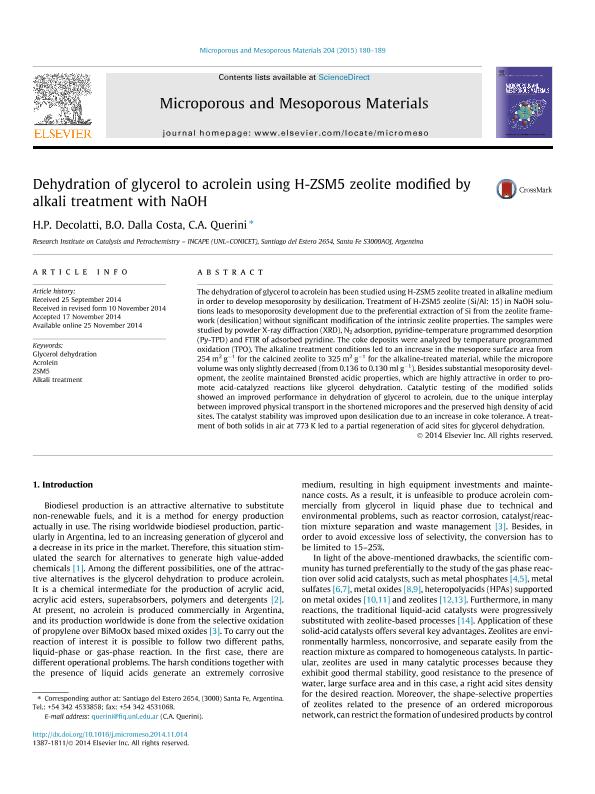Artículo
Dehydration of glycerol to acrolein using H-ZSM5 zeolite modified by alkali treatment with NaOH
Fecha de publicación:
11/2014
Editorial:
Elsevier
Revista:
Microporous and Mesoporous Materials
ISSN:
1387-1811
Idioma:
Inglés
Tipo de recurso:
Artículo publicado
Clasificación temática:
Resumen
The dehydration of glycerol to acrolein has been studied using H-ZSM5 zeolite treated in alkaline medium in order to develop mesoporosity by desilication. Treatment of H-ZSM5 zeolite (Si/Al=15) in NaOH solutions leads to mesoporosity development due to the preferential extraction of Si from the zeolite framework (desilication) without significant modification of the intrinsic zeolite properties. The samples were studied by powder X-ray diffraction (XRD), N2 adsorption, pyridine-temperature programmed desorption (Py-TPD) and FTIR of adsorbed pyridine. The coke deposits were analyzed by temperature programmed oxidation (TPO). The alkaline treatment conditions led to an increased mesopore surface area from 254 m2 g-1 for the calcined zeolite to 325 m2 g-1 for the alkaline-treated material, while the micropore volume was only slightly decreased (from 0.136 to 0.130 ml g-1).Besides substantial mesoporosity development, the zeolite maintained Brönsted acidic properties, which are highly attractive in order to promote acid-catalyzed reactions like glycerol dehydration. Catalytic testing of the modified solids showed an improved performance in dehydration of glycerol to acrolein, due to the unique interplay between improved physical transport in the shortened micropores and the preserved high density of acid sites. The catalyst stability was improved upon desilication due to an increase in coke tolerance.
Palabras clave:
Glycerol Dehydration
,
Acrolein
,
Zsm-5
,
Alkaline Treatment
Archivos asociados
Licencia
Identificadores
Colecciones
Articulos(INCAPE)
Articulos de INST.DE INVEST.EN CATALISIS Y PETROQUIMICA "ING. JOSE MIGUEL PARERA"
Articulos de INST.DE INVEST.EN CATALISIS Y PETROQUIMICA "ING. JOSE MIGUEL PARERA"
Citación
Querini, Carlos Alberto; Dalla Costa, Bruno Oscar; Decolatti, Hernán Pablo; Dehydration of glycerol to acrolein using H-ZSM5 zeolite modified by alkali treatment with NaOH; Elsevier; Microporous and Mesoporous Materials; 204; 11-2014; 180-189
Compartir
Altmétricas




